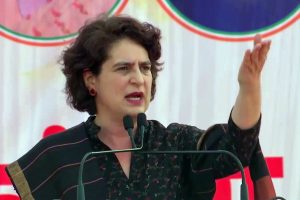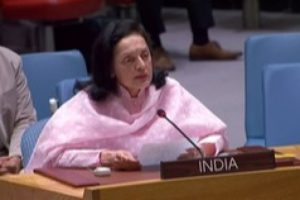Few know that besides its centuries-old Jain heritage of amazing temples, Jaipur’s neighbour, Mount Abu, after Partition, became a virtual Vatican of the East when Prajapati Dada Lekhraj moved there from Sindh, which had become a part of newly-established Pakistan.
The institution of Bramakumaris and Bramakumars that he had set up flourishes as probably the newest religious congregation. After meeting Priyanka Behn, originally an MBA from Meerut, the live-wire Brahamakumari, who holds daily Rajyoga meditation sessions in Delhi’s DDA colony of Mayapuri in a flat put at her disposal by HL Grover, a retired Agricultural Scientist of Pusa Institute, one comes back greatly enlightened.
Priyanka Behn comes on her cream scootie, complete with a white helmet and matching saree, every forenoon from the Bramakumari Centre in nearby Pratapnagar to popularize her mission among mainly the women residents, who are just as enthusiastic as her, to carry forward the legacy of Dada Lekhraj.
One met the enterprising Behn and she produced a wealth of information on her sect, along with this article by Nevile R Smith, former Head of the English Dept of Raja Balwant Singh College, Agra. Neville was invited to Mount Abu some five decades ago and this is what he contributed as a research article in a literary journal that is worth reproducing for the benefit of Jaipurwallahs, who are only vaguely aware of the religious significance of the Brahmakumaris’ movement in neighbouring Mount Abu of Ajmer district:
“A stone’s throw from Mount Abu’s exotic Nakki Lake, perched five thousand feet above sea level, lies Madhuban, earthly headquarters of the ‘godly’ university of the Brahmakumaris (daughters of Brahma). Your car climbs the zig-zag mountain road, leaves Nakki Lake, with all its shore-side cluster of tourist shops and gala evening sights on the left and old downtown Abu on the right and stops gently by Pandava Bhavan.
You enter smoking and jabbering away animatedly. The next moment the cigarette slips away and instead of loud-pinched argumentation you find yourself speaking in whispers: two signs, ‘No Smoking’ and ‘Silence’ have forced you to comply. Fifty yards in and you find yourself in a neatly paved quadrangle. You are standing before the graceful marble memorial of Pitashri Brahmakumar, founder of the university, and read his sayings engraved around the shrine: ‘Mount Abu is the holiest place of pilgrimage in India. In Abu, Madhuban is the holiest spot. Remember this always’.
“Sisters of the congregation, dressed in immaculate white, full-sleeved blouses and neatly draped sarees, usher you to their Prayer Hall. You enter amidst the aroma of incense and seat yourself on the white sheets, spread from wall to wall to wall and face huge pictures of the history of religion and of the origin and destiny of the soul. Nearer you are three ornamental stools, all covered and cushioned in White. Even as you are engrossed in the panels, an inmate of the ashram announces the arrival of the Yogin, Prakash Mani, a grayish sexagenarian, Administrative Head of the Brahmakumaris Goldy University, (who is dead now).
“Founded in 1937 by Dada Lekhraj, a Sindhi millionaire jeweler- turned-saint, the sect prefers to call itself a university and its adherents students, on whom are entailed the rigours of twentieth-century monasticism strict celibacy, self-abnegation and complete identification with the cause in hand, the spiritual rejuvenation of mankind.”
The university operates through its over 200 centres in India and a few countries of South-East Asia and a dozen Spiritual Museums (really picture stories of the university’s conception of the universe) that tell the faithful his place in the scheme of things, as also of the cycle of universal life. This cycle, the adherents believe, is nearing completion, as the darkness of Kali-yuga, the age of evil, gives place to the dawn of Satyuga, the much dreamed- of golden age that will set at rest all human problems and give to all everlasting bliss.
“Like the Doomsday Sects, the Brahmakumaris await the final catastrophe that would end the world of evil. In fact, through a curious arithmetic, they have arrived at the precise time when the world will end, emphatically pointing to the movement towards a general and total involvement of the countries of the world in a final conflagration, a third and last World War.
“The adherents of the faith insist theirs is not just another sector Math, but a ‘revolutionary movement’ that aims at removing the ‘cobwebs of confusion’ and ‘imparting universal spiritual education’ to people of all denominations, enabling them to inculcate divine qualities in themselves. Thus religion is no dividing line for the Brahmakumaris. It is the human soul that counts. Besides Hindus, Sikhs and Muslims have joined the movement. In fact it is claimed that the Poona Centre of the mission is being run by Muslims.”
The Brahmakumaris drive their name from Prajapita Brahma (the rechristened name of Dada Lekhraj), who is venerated as the spiritual father and the “medium” through whom Parampita Shiva speaks. The Prajapita died at the age of 93, after firmly establishing the sect and shifting the headquarters to Abu from Hyderabad Sindh, from where its adherents migrated to India in 1951. No one has succeeded the Prajapita, because there is no gurudom in the sect.











